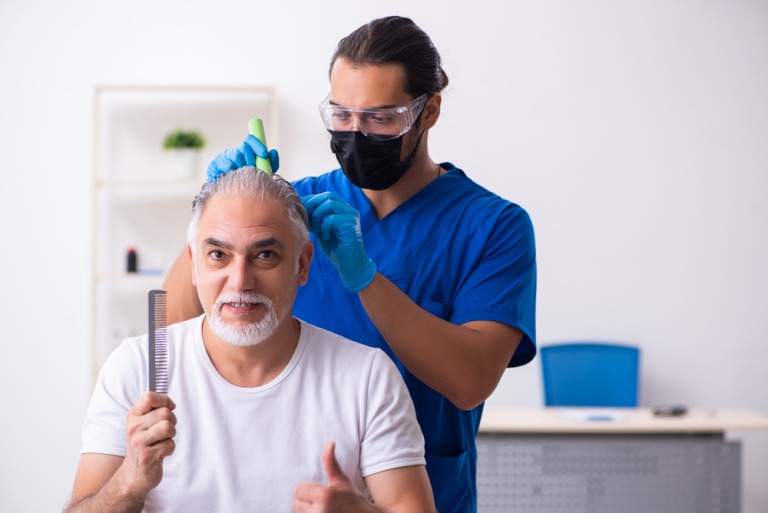Nutrition plays a crucial role in every aspect of our health, including recovering from a hair transplant. A balanced diet can expedite healing, reduce inflammation, and support the growth of healthy hair follicles.
Whether you’re preparing for a transplant or currently in recovery, knowing which foods to eat and which to avoid can make a significant difference in your results.
Foods That Promote Healing and Hair Growth
During your recovery period, focus on incorporating lean proteins such as chicken, fish, and beans into your diet. Proteins are essential for tissue repair and rebuilding, which is crucial after undergoing surgery. Donor hair grows back when you’re getting the right nutrition.
Plus, it may benefit the new grafts too. Additionally, omega-3 fatty acids found in salmon, flaxseeds, and walnuts can help reduce inflammation and promote overall scalp health. Don’t forget to load up on fruits and vegetables rich in vitamins A, C, and E, like spinach, carrots, and citrus fruits. These vitamins are vital for maintaining the health of your hair and scalp.
Hydration: The Role of Water
Staying hydrated is key to supporting your body’s natural healing processes. Water helps transport nutrients to cells, including those responsible for hair growth. Aim to drink at least 8-10 glasses of water a day, and consider adding herbal teas or infused water for added hydration and flavor.
Foods Rich in Biotin and Zinc
Biotin, also known as vitamin B7, is crucial for hair growth as it supports the production of keratin, a protein that makes up your hair, skin, and nails. Foods like eggs, nuts, and sweet potatoes are excellent sources of biotin.
Zinc, found in foods like oysters, beef, and chickpeas, plays a role in maintaining scalp health and supporting hair growth by helping to regulate hormones and enzymes.
Iron-Rich Foods
Iron deficiency can contribute to hair loss, so it’s essential to include iron-rich foods in your diet such as lean red meat, spinach, and lentils. Iron is crucial for transporting oxygen throughout the body, including to your scalp and hair follicles, promoting healthy hair growth.
Foods High in Vitamin C
Vitamin C is a powerful antioxidant that helps protect cells from damage and supports collagen production. Collagen is essential for maintaining the structure of hair follicles. Incorporate foods like strawberries, bell peppers, and citrus fruits into your diet to ensure you’re getting an adequate amount of vitamin C.
Healthy Fats: Avocado and Nuts
Healthy fats are essential for maintaining scalp health and promoting hair growth. Avocados are rich in monounsaturated fats, which can help nourish the scalp and hair follicles. Nuts, such as almonds and walnuts, provide essential fatty acids like omega-3s and omega-6s, which support overall hair health.
Foods to Avoid During Recovery
While focusing on nutrient-rich foods, it’s also important to steer clear of certain foods that could hinder your recovery. Avoid excessive consumption of sugary foods and beverages, as they can contribute to inflammation and potentially slow down the healing process.
Processed foods, which are often high in unhealthy fats and low in nutrients, should also be minimized to support overall health and well-being.
Alcohol and Caffeine Consumption
During your recovery period, it’s advisable to limit your intake of alcohol and caffeine. Both substances can dehydrate your body, which may affect your overall healing process. Instead, opt for hydrating beverages like water and herbal teas to support optimal recovery.
Redness After a Hair Transplant: Is This Normal?
When it’s your first time having a hair transplant, you often don’t know what to expect. Some people deal with the recovery very well and have minimal side effects. Others can have a long journey that affects their self-esteem. Indeed, everyone deals with surgery differently, and this is something that you won’t know until you get started.
For example, if you suddenly see redness on your scalp after a hair transplant, is this a side effect that’s normal? The answer is yes. Let’s take a closer look at what you need to know about redness and what you can do to make yourself feel better.
Normal After the Surgery
Remember that you’re going through surgery with a hair transplant. Due to this procedure, there will be redness visible on the scalp and skin. This is due to the extract and implant of the hair grafts, which causes inflammation. Most patients have this initial redness, which is referred to as erythema.
Therefore, there’s no need to panic when you see redness on the scalp. This can last for a couple of weeks as the grafts need time to heal. Some patients will notice that the redness goes away quickly. Others might see it last for up to one month. Just know that it’s not something you should worry about.
Ways to Manage Redness
Often, you have to let the redness run its course. But, there are things you can do to make sure you manage the situation and don’t contribute to inflammation. For example, you don’t want to be out in the sun and exposing your scalp.
This can lead to sunburn, which is going to make matters worse. In fact, it can damage hair grafts. So, always ensure that you’re wearing a hat during the healing process.
Something else you need to do is be gentle with your scalp. In particular, you don’t want to itch at the affected areas or pick at scabs. You should also avoid using very hot water on the scalp or strong products. This can all contribute to inflammation and potentially damage the hair grafts.
Conclusion
In conclusion, a nutrient-rich diet plays a crucial role in supporting hair transplant recovery. By incorporating foods that promote healing, such as lean proteins, fruits, and vegetables, and avoiding processed foods and excessive sugars, you can enhance your recovery process and promote healthy hair growth.
Remember to stay hydrated, limit alcohol and caffeine intake, and consult with your healthcare provider for personalized nutritional advice. By following these tips, you can optimize your recovery and achieve the best possible results from your hair transplant surgery.








